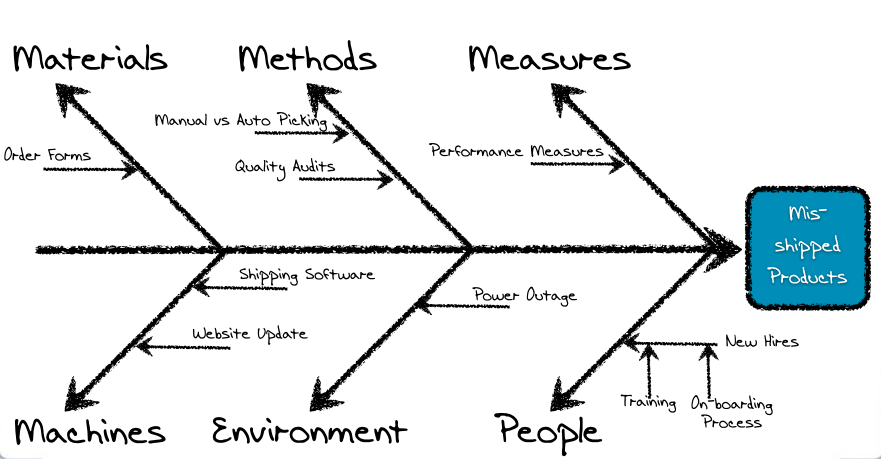

After all, the Fishbone and PM are screening tools - they are meant reduce the focus onto the vital causes on the Effect (Y). The team has to make a decision on where that cut-off point is since not all inputs should be transferred to the FMEA. Once all the inputs are scored, the scores are sorted from highest to lowest and the highest scores are transferred to the FMEA. The higher the score relative to the other scores, the greater the impact that cause (x) has on the Effect (Y). That score represents its impact on the Effect (Y). The PM assigns numbers to each input and attempts to objectively score each "cause". Be careful how many are transferred to the PM because each input is weighed (scored by the team) in the PM phase and a lot of inputs could take a lot of time to score. The next tool called a Prioritization Matrix (PM) which is also sometimes called a C ause & Effect Matrix or Correlation Matrix will start the screening process (aka the funneling process) to filter out the trivial inputs.ĭuplicates x's are removed from the Fishbone Diagram and the remaining Controllable inputs are inserted into a Prioritization Matrix (PM).ĬAUTION: There could be 10-20 or there could be hundreds.

It is not important to weigh these inputs at this time, more importantly get all inputs documented and keep opinions and judgments from interfering.
#ISHIKAWA DIAGRAM CATEGORIES PRO#
Many pro cess steps may share the same inputs (x's) but the Fishbone Diagram is done individually for each step and for each category to help capture ALL inputs before proceeding. In this case many inputs occur to both "Y's but there will be many inputs that must be identified that will only apply to one or another. C – controllable input (such as processing temperature)Īt the end of this exercise, all inputs, x’s, should be identified and labeled as "C" or "N".Ī Fishbone Diagram should be done for each major process step and other project y's.Ī project may have a goal to improve the scrap rate and customer satisfaction rate.N – noise, not controllable by the team (such as outdoor humidity).Do not get caught up on which category to list an input under when it is debatable, it is more important that the input has been captured.Īfter all of the inputs are listed, each one should be identified as either: It is not so important under which category each input is listed as long as it is identified and put on the list for further analysis. The categories normally found in a manufacturing environment are:ġ) Measurement – root causes from measurement devicesĢ) Manpower – root causes from people involved directly or indirectlyģ) Machine – root causes from machine(s) involvedĤ) Method – root causes from the procedure used or doneĥ) Material – root causes from direct or indirect materials usedĦ) Environment – root causes from surroundings The appearance of the diagram isn't as important as capturing all the inputs. Eventually, the root causes should be the smallest bones on the skeleton. Some inputs have their own "causes" and these become “bones” branching off the larger bones, and this may go on two or three levels. The project problem or gap, " Y", as the head of the fish and the bones are the primary cause categories.Ĭategorizing the major causes helps the team focus their thoughts around one major input area at a time to identify root causes. The name Fishbone Diagram comes from the configuration of the diagram. This identification of these inputs requires a well-represented and engaged team, this is where the substance of the work begins to improve the process, product, or service. The linkage of the Fishbone Diagram to other tools is shown below.

Some will be subjective and generated from brainstorming discussions and some will be shown by data, facts, and charts such as Pareto Diagrams. To begin the process of finding and documenting the inputs to the problem from the obvious to the hidden causes. Often this beginning phase of subjective root cause analysis runs concurrently with the Measurement Systems Analysis (MSA). It initiates the collection of the all root causes, x’s, or inputs that contribute to the problem, also referred to as the effect or "Y". In a DMAIC Six Sigma project this tool is used in the MEASURE phase. This is one of the most commonly used tools of continuous improvement programs and is one of the 7 Basic Quality Tools bundled together by Ishikawa. Its shape has earned the nickname of the Fishbone Diagram. Juran honored Ishikawa by naming the tool after him and is now also known as the Ishikawa Diagram. The first company to adopt the diagram in all of its processes was Kawasaki Iron Fukiai Works in 1952. The Fishbone Diagram was originally created by Kaoru Ishikawa to find process imperfections (Ishakawa, 1985). Fishbone Diagram (Ishikawa Diagram or Cause & Effect Diagram)


 0 kommentar(er)
0 kommentar(er)
